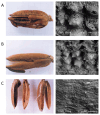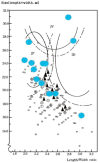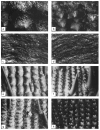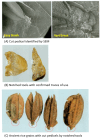The First Domesticated 'Cheongju Sorori Rice' Excavated in Korea
- PMID: 39065475
- PMCID: PMC11280956
- DOI: 10.3390/plants13141948
The First Domesticated 'Cheongju Sorori Rice' Excavated in Korea
Abstract
Archaeological excavations led by Yung-jo Lee and Jong-yoon Woo were carried out twice at the Sorori paleolithic site, Cheongju, in the Republic of Korea, at the upper stream of the Geumgang river, the Miho riverside. A total of 127 rice seeds were excavated, including 18 ancient rice and 109 Quasi-rice, in 1998 and 2001. At the first excavation, eleven short japonica-type ancient rice and one slender smooth ancient rice with two kinds of Quasi-rice were excavated. The average length of the 11 short rice grains obtained from the first and second excavation was 7.19 mm and the average width was 3.08 mm, respectively. The Quasi-rice are apparently different from the rice and do not have bi-peak protuberances on their glume surface. At the second excavation, six short ancient rice chaffs and some Quasi-rice 2 were found. These short-grained ancient rice were comparable to the ancient rice that were excavated at the Illsan Neolithic site. Geologists and radiologists confirmed that the peat layer in which the rice found was older than 15,000 years. In this study, the morphological characteristics, crushing, and DNA band patterns related to the genetic polymorphism of rice grains in Cheongju Sorori were compared and analyzed for genetic similarities and differences with wild rice, weed rice, and modern rice. The morphological, ecological, and physiological variations in rice grains excavated from the Sorori site were presumed to denote the origin of rice domestication in Korea. It is also suggested that the results of the DNA sequencing of excavated rice are very important clues in estimating the origin of the early domestication of rice.
Keywords: Sorori rice; early domesticated rice; origin of rice; paleolithic; peat layer; quaternary geological layer.
Conflict of interest statement
The authors declare no conflicts of interest.
Figures



















References
-
- Chang T. The origin, evolution, cultivation, dissemination, and diversification of Asian and African rices. Euphytica. 2004;25:425–441. doi: 10.1007/BF00041576. - DOI
Publication types
Grants and funding
LinkOut - more resources
Full Text Sources

